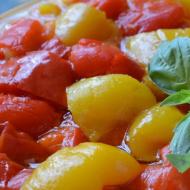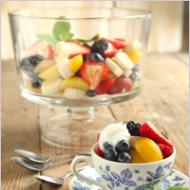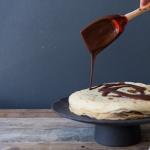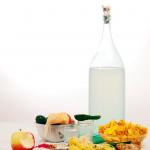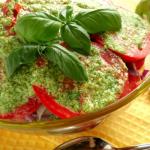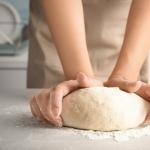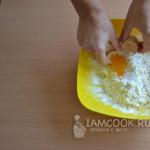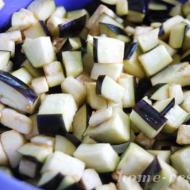
Madeleine cake classic recipe. Madeleine cakes. Madeleine cookies with poppy seeds from Gordon Ramsay
Cookies “Madeleine” (madeleine) is a confectionery classic of French cuisine, enjoying well-deserved success among sweet tooths all over the world. At its core, it is a small shell-shaped sponge cake that first appeared in Lorraine in northeastern France in the 18th century. Traditionally, they are made from a delicate dough, to which fleur-d’orange is added - orange water. According to one version, madeleines got their name from the name of the young girl Madeleine Paulmier.
In 1755, Stanislav Leszczynski, Duke of Lorraine and father-in-law of Louis XV, gave a large dinner at the Chateau de Commercy. During preparation, a serious dispute broke out between the manager and the cook, which grew into a scandal. Ultimately, the chef went on strike, refusing to prepare desserts for the ducal table. Saved the situation maid Madeleine, who volunteered to make cookies according to her grandmother’s recipe. The unusual taste of the cookies delighted the Duke and his retinue and soon “ madelenki" became a popular delicacy in Versailles. At least that's what the legend says.


But madeleine cookies gained widespread fame thanks to Marcel Proust’s seven-volume epic “ In search of lost time
" Proust (1871-1922) entered the history of world literature as one of the brightest representatives of French modernism and the founder of modern psychological prose. He laid the foundations for a new type of literature called “stream of consciousness” literature. At the heart of his monumental work is the study of the transformation of the human self over time, and the main idea is that Time can only be found through an appeal to the sublime. Creativity is the ability to go back, plunging into previous sensations and long-forgotten experiences.
The episode dedicated to the Madeleines has become one of the most quoted in world literature.
“For many years now, since Combray nothing more existed for me except the theater of the drama of my going to bed, and so, one winter day, when I came home, my mother, seeing that I was cold, offered me a drink, against my customs, a cup of tea. At first I refused, but, I don’t know why, I changed my mind.  Mom told me to give me one of those round and pot-bellied cakes called Petites Madeleines, the molds for which seem to be the grooved shells of mollusks of the type of scallops. And immediately, dejected by the dull day and the prospect of a sad tomorrow, I mechanically raised a spoon of tea to my lips, in which I soaked a piece of madeleine. At that very moment, when a sip of tea with crumbs of cake touched my palate, I shuddered, amazed at the unusualness of what was happening in me. A sweet sensation spread through me in a wide wave, seemingly without any reason. It immediately filled me with indifference to the vicissitudes of life, made its adversities harmless, its transience illusory, just as love does when it fills me with some precious essence: or, rather, this essence was not in me, it was me. I no longer felt mediocre, random, mortal. Where could this powerful joy come to me? I felt that it was related to the taste of tea and cake, but it was immeasurably superior to it, it must have been of a different nature. Where did she come from? What did it mean? Where can I grab it? I drink a second sip, in which I find nothing more than what was contained in the first, I drink a third, which brings me a little less than the second. It's time to stop, the power of the drink seems to be weakening. It is clear that the truth I seek is not in him, but in me”.
Mom told me to give me one of those round and pot-bellied cakes called Petites Madeleines, the molds for which seem to be the grooved shells of mollusks of the type of scallops. And immediately, dejected by the dull day and the prospect of a sad tomorrow, I mechanically raised a spoon of tea to my lips, in which I soaked a piece of madeleine. At that very moment, when a sip of tea with crumbs of cake touched my palate, I shuddered, amazed at the unusualness of what was happening in me. A sweet sensation spread through me in a wide wave, seemingly without any reason. It immediately filled me with indifference to the vicissitudes of life, made its adversities harmless, its transience illusory, just as love does when it fills me with some precious essence: or, rather, this essence was not in me, it was me. I no longer felt mediocre, random, mortal. Where could this powerful joy come to me? I felt that it was related to the taste of tea and cake, but it was immeasurably superior to it, it must have been of a different nature. Where did she come from? What did it mean? Where can I grab it? I drink a second sip, in which I find nothing more than what was contained in the first, I drink a third, which brings me a little less than the second. It's time to stop, the power of the drink seems to be weakening. It is clear that the truth I seek is not in him, but in me”.
Thanks to “madeleines,” the hero of the novel is transported back in time, to a cloudless childhood with which he associates the taste of cookies. In French the expression “ Proust's Madeleine” has become a stable metaphor, denoting not only the “taste of childhood,” but also any simple thing that brings us back to memories of happy moments of a past life. Famous French philosopher Gilles Deleuze in his work “ Marcel Proust and signs ” examines in detail the phenomenon of “Madeleine” as “ an involuntary gateway to a whole avalanche of memories”.

… This taste was the taste of a piece of madeleine that Aunt Leonie treated me to on Sunday mornings in Combray, after soaking it in tea or linden blossom tincture, when I came to her room to greet her. When nothing remains from the long past, after the death of living beings, after the destruction of things, only more fragile, but more tenacious, more insubstantial, more persistent, more faithful, smells and tastes continue for a long time, like souls, to remind of themselves , wait, hope, continue, among the ruins of everything else, to carry, without exhausting under its weight, on its barely perceptible drop, the huge edifice of memory”.
Marcel Proust, “Towards Swann” (1913)
 Over the many years of its existence, the classic recipe for making madeleine cookies has acquired an incredible number of different variations. In modern recipes, exotic fleur-d’orange is replaced with orange or lemon zest, and additional ingredients are often used: honey, tea, liqueur, rum, cocoa, chocolate, syrup, berries, various flavorings, etc.
Over the many years of its existence, the classic recipe for making madeleine cookies has acquired an incredible number of different variations. In modern recipes, exotic fleur-d’orange is replaced with orange or lemon zest, and additional ingredients are often used: honey, tea, liqueur, rum, cocoa, chocolate, syrup, berries, various flavorings, etc.
They are baked in special shell-shaped molds, but you can also use other small cake molds.
Recipe for vanilla-lemon madeleine cookies
 Ingredients
:
Ingredients
:
2 large eggs
2/3 cup sugar
1 tea boat vanilla extract
1/2 teaspoon lemon zest
1 cup flour
10 tablespoons melted butter
Pinch of salt
Beat eggs with sugar until white. Add flour and mix with a mixer until completely smooth. Pour in the melted butter (not hot!), add zest, vanilla extract and salt, mix again with a mixer. Let the dough rest for at least 10 minutes before baking. in a cold place.
Divide the dough into the molds, having previously greased them with oil. Fill the molds 1/2 full, because... The dough will rise during baking. Bake in a preheated oven (180–200 degrees) for 7-10 minutes. When the madeleines have turned light yellow, check with a match for doneness and remove from the oven.
Recipe for honey madeleine cookies
 Ingredients
:
Ingredients
:
½ cup melted butter
1 ½ cups flour
1 teaspoon baking powder
3 eggs at room temperature
½ cup sugar
½ cup honey
Powdered sugar
Mix eggs, sugar and honey. Beat with a mixer at high speed until the mixture increases in size and turns white (about 5 minutes). Mix the flour with baking powder and combine with the honey-egg mixture. Pour in the melted butter and mix until smooth. Place the dough in the refrigerator for 1 hour.
Preheat the oven to 190C. Grease the mold with oil and fill the mold no more than 2/3 full with dough. Bake for 10-12 minutes until the edges of the cookies are golden brown. Sprinkle cooled cookies with powdered sugar.
Chocolate madeleine cookies recipe
 Ingredients
:
Ingredients
:
70 g flour
90 g sugar
3½ tablespoons cocoa powder
½ teaspoon baking powder
2 large eggs at room temperature
100 g melted butter
pinch of salt
Mix together flour, cocoa and baking powder. Beat eggs with sugar and a pinch of salt until white. Add flour and butter to the eggs and mix until smooth. Cover the dough with plastic wrap and refrigerate for 1 hour.
Grease the molds with oil and fill no more than 2/3 of the volume with dough. Bake in a preheated oven (180C) for 10-15 minutes. until ready.
Recipe for Madeleine cookies with berries
 Ingredients
:
Ingredients
:
100g sugar
100 g wheat flour
100 g melted butter
2 eggs
1 packet vanilla sugar
Berries (currants, blueberries, raspberries, etc.)
Using a mixer, mix eggs, sugar and vanilla sugar. Add flour and gently mix with beaten eggs. Add melted butter and mix until smooth.
Grease the molds with oil and place the dough halfway between the molds. Place the berries on top and press them into the dough. Preheat the oven to 190C and bake the cookies until done. If desired, the finished cookies can be sprinkled with powdered sugar. Serve with yoghurt and add fruit.
French delicacy - Madeleine cookies
Cookie " Madeleine"is a truly iconic French confectionery product that has incredible softness, airiness, tenderness and a delicate aroma. The French sacredly honor his cult, because Madeleines represented France at Europe Day according to the program The Cafe Europe.
Legends of the creation of French Madeleine cookies - a dessert with a long history

Stanislav Leszczynski and his daughter Maria
Cookie " Madeleine"is simply covered in legends, but in each of them it is mentioned Stanislav Leszczynski- Duke of Lorraine, who lived in the 18th century. According to one of them, he was expelled to Lorraine and lived there with his daughter Maria. The Duke's maid loved little Maria very much and prepared a delicious cake for her and her father. Maria later married Louis XV- King of France. She took the recipe for the cookies she liked with her to Paris and passed it on to the pastry chefs. Versailles under the name of that same maid - Madeleine.
According to another legend, in 1755 Leszczynski hosted a dinner party in Paris. But just before the celebration, the pastry chef fell ill, and the enterprising cooks entrusted the girl with Madeleine bake cookies according to her grandmother's recipe, which she often treated them to. The dessert created a real sensation, so the cookies were named after the girl.
However, the “culprit” behind the popularity of baking remains Maria Leszczynski. By her order, the cookie recipe was handed over to the confectioners of Versailles, and soon it was served at the table of King Louis. Thus, the legendary liver is almost 260 years.
But what can we say about “ Madeleine"if you need to try it. Marcel Proust, famous French short story writer, gave the taste " Madeleine"special, magical meaning. The taste of cookies can evoke a flood of memories, as happened with the hero of the work “ In search of lost time" He has seen these cookies many times in the windows of confectionery shops, but the keeper of the meaning is the smell and taste, the taste of those very “ Madeleine”, capable of “without exhaustion carrying a huge building of memory in its barely perceptible drop.” You can listen for a long time and contemplate the delights " Madeleine", but you should definitely try a "piece of France".
Madeleine cookie recipes
Like a real woman, " Madeleine“It’s boring to flaunt around in one outfit for so many years. She decided to “put on new clothes,” but the excellent taste and delicacy of the cookies did not become worse at all. On the contrary: the new outfits only made this dessert even more beautiful!
Madeleine with lemon zest from Alexandre Dumas

One of the best classic recipes " Madeleine» introduced Alexandre Dumas V " Culinary dictionary».
The great novelist was a great connoisseur of French cuisine, and he simply loved to eat deliciously. During Dumas's lifetime " Madeleine"was already very popular, and the writer could not ignore it.
In order to feel the taste of that time, we will leave the recipe in the original, of course, translated from French: “ Grate a piece of sugar with the zest of two citrons (lemons or oranges), finely grind the sugar to powdered sugar. Weigh out 9 ounces of the mixture, add 8 ounces of flour, sifted through a sieve several times, 6 eggs and 4 yolks, a pinch of salt and 2 tablespoons of vodka, mix with a wooden spatula.
Melt 10 ounces of butter from Isigny, skimming thoroughly. When foam stops appearing, the oil is ready. Strain it into another pan and cool. Pour the oil into the madeleine mold, then pour into the next mold, and so on. Each mold should retain a little oil, which will then flow down the walls to the bottom and give the cake a beautiful pattern.
Add the remaining oil to the dough, place the roasting pan over low heat and stir gently so that the dough does not burn. After a few minutes, when the dough begins to melt, remove it from the heat. Divide the dough into the molds without letting it cool». Note: ounce = 28.35 g. Isigny is a commune in Lower Normandy, France.
Madeleine cookies with poppy seeds from Gordon Ramsay

Madeleine cookies with poppy seeds
Ramsay in his recipe he uses 100 grams of butter, 3 eggs, 100 grams of flour and the same amount of sugar, 1 tablespoon of poppy seeds and the zest of one lemon.
First you need to melt the butter. Beat the eggs with a whisk until creamy and double in volume. Add sifted flour, zest and poppy seeds to the eggs. Then stir in the cooled butter.
Pour the dough into the mold, bake for 10-12 minutes at 180 degrees. The chef recommends stirring the dough very carefully so that it does not lose its airiness, and not opening the oven while baking.
Chocolate cookies "Madeleine" by Pierre Hermé from the book "Le LAROUSSE des DESSERTS"
According to the recipe of this culinary virtuoso, you need to sift together 70 grams of flour, 3.5 tablespoons of cocoa and 1.5 teaspoons of baking powder. Separately mix 90 grams of sugar, a pinch of salt and the zest of a quarter of a lemon. Using your fingers, rub the sugar until moist. Using a whisk, beat 2 eggs, add them to the sugar-lemon mixture and stir until smooth.
Squeeze the butter with your fingers and add small portions to the dough, continuing to whisk. Add flour mixture. Stir until smooth. Place the dough in a cool place overnight.
Pierre Hermé comments: " The characteristic bulge in the center of “Madeleine” is the result of overnight time in the refrigerator. Even if you are in a hurry, still keep the dough in the cold for at least one hour. You won’t achieve bulge, but the Madeleines will bake much better and won’t seem raw inside. ».
Pierre Hermé describes the baking process " Madeleine" Thus: " The oven needs to be preheated to 220° C. Place the cookies in the oven. At the same time, insert the handle of a wooden spatula into the oven door so that air penetrates slightly. As soon as the temperature drops to 180 degrees, close the oven door. Then bake the madeleines for about 15 minutes until they have risen and are elastic to the touch.».
Tip for storing cookies " Madeleine» from Erme: « Store Madeleine at room temperature in a hermetically sealed box for no more than two days. If the cookies become slightly stale, don’t be upset: dip them in hot coffee and enjoy the taste of Madeleine».
You can decorate chocolate " Madeleine“In this way: melt 50 grams of white chocolate, grind pistachio nuts in a coffee grinder. Dip cooled cookies into chocolate and nuts. Place on a baking sheet lined with parchment and place in the refrigerator for 10 minutes until the chocolate hardens. If you love orange flavor, you can make orange madeleine cookies. It is prepared in the same way as lemon, only grated zest and juice of 1 orange are added to the main ingredients.
Madeleine cookie recipe with step-by-step photos
So, having learned from the best confectioners, let's start making cookies " Madeleine" To do this you need from your inventory:
- 2 bowls;
- cup;
- tablespoon and teaspoon;
- mixer or whisk;
- shell-shaped.
Using the ingredients we apply the rule "3 x 100«:
— 100 grams of butter;
- 100 grams of powdered sugar;
- 100 grams of flour;
- 1 tablespoon cocoa;
- a pinch of salt.
Cooking process
Let's turn on pleasant French music and start cooking. A good mood and a light smile will help in preparing this wonderful delicacy.
Step 1. Melt the butter. The butter must be “boiled” in a water bath or low heat, slightly evaporating the milk until a slight foam appears. Thanks to this, the cookies will be more crumbly and simply melt in your mouth.

Melt the butter
Step 2. Beat the eggs. Beat the eggs thoroughly with a whisk or mixer until fluffy and their volume has at least doubled. There is no baking powder in this recipe, since classic cookies are prepared without it. Eggs, with the correct beating technology, themselves act as a leavening element in the dough.

Beat the egg into a fluffy foam
Advice! Do not use cold eggs, let them warm up, then they will beat better. To make the egg foam fluffier and more airy, use a large-diameter whisk.
Step 3. Add powdered sugar. Continuing to beat the eggs, carefully add powder in small portions. Using powder instead of sugar softens the texture of the dough, making the cookies more tender.

Add powdered sugar
Step 4. Mix eggs with flour and zest. Once all the powdered sugar has been added, set the mixer aside. Grate the lemon zest. Then sift the flour into the egg mixture through a fine sieve, add the zest and very carefully, using up and down movements, not in a circle, mix all the ingredients.

Mix eggs with flour
Advice! Pour boiling water over the lemon before grating it to soften it and enhance the flavor.
Step 5. Add oil. Pour the cooled melted butter into the dough in a thin stream along the side of the bowl, stir thoroughly. It is important to maintain a middle ground here. If you mix too intensely, the dough will seem raw; if you don’t mix, you risk being left without the proverbial “cap.” Divide the dough in half, add cocoa to one part.

Pour in oil
Step 6. Let the dough rest. Cover the finished dough with film and refrigerate for at least 5 hours, or preferably overnight. This stage is very important: if the dough does not settle, it will not rise well.

Let the dough sit
Step 7: Baking. Grease the mold with butter and sprinkle with flour. It’s better to grease even a silicone mold so that the pattern on the cookies is clearer. Fill the mold 70% with dough.

Fill the form 70% with dough
Feature of cookies " Madeleine" is the characteristic "comb". Every pastry chef has his own secret on how to achieve it. Let's check one of these secrets. Place the cookies in an oven preheated to 220 degrees for 3 minutes, then turn off. The products are suitable within 10 minutes. Then turn the oven back on at 160 degrees and bake “ Madeleine» until golden brown, about 5-6 minutes. Do not open the oven during baking. This method really works. Through the glass of the oven you can see how the cookies rise literally before your eyes. And here is the result:

Freshly baked madeleine cookies
Many confectioners claim that any biscuit product does not tolerate loud sounds and footsteps during baking. Try to keep the kitchen quiet while baking." Madeleine" Bon Appétit!
Did you like the article? to always be up to date with events.
Madeleine cakes or simply Madeleines. This is a classic French dessert that Marcel Proust adored. He wrote about them in his novel: “She sent for those small, plump cakes called petites madeleines and look like small shells... Exceptional pleasure is imprinted on my mind..."
These tender and airy little cakes or just biscuits can come in different flavors. Traditionally, they are prepared with the addition of lemon or orange water, which is made from citrus flowers, and this water is called the beautiful French word “orange blossom”.
These cakes look amazing because the dough is poured into a shell-shaped mold.
To prepare you will need:
130 g sugar
1 tbsp. starch
Additive options:
Cocoa powder
- candied fruits
- candied cherries
- lemon/orange zest
- strong black coffee
- chocolate
Let's start preparing the dough. Turn on the oven to preheat at 190 degrees.
Melt the butter over low heat. I did this in the microwave.
Prepare a bowl or any other utensil that you can place in the water bath. Break the eggs there, mix in vanilla and regular sugar. If you find orange water, put it there too.
Place the pan in a water bath and whisk until a thick light cream is obtained.
This procedure took me about 8 minutes. I beat with both a whisk and a mixer. I even thought that nothing would work out for me. But everything worked out, fortunately.
As soon as the cream is formed, remove the vessel from the heat and beat for another two minutes so that the cream cools slightly. Sift the flour and pour into the cream, stirring constantly.
Having reached a homogeneous dough, pour melted butter into the mixture. Stir thoroughly. Here you can add various fillers. I wanted to try the taste of classic madeleines, so I didn’t add anything.
That's it, the dough is ready and you can fill the molds and bake. The easiest way to do this is with a teaspoon or dessert spoon.
Bake for 10-15 minutes. It all depends on your oven. But constantly check the readiness of the dough after 10 minutes. It should be soft and springy.
This amount of dough was enough for me for 3 batches. I added a little cocoa to the last batch.
Their taste is truly very, very unusual and pleasant. These cakes are perfect for tea or coffee! The dough is not dry. Next time I will definitely try with different flavors.
I hope you will be inspired by my story and also try a dish from the times of Louis 15th.
I wish you a pleasant tea party.
To receive the best articles, subscribe to Alimero's pages.
There is such a famous French dessert - Madeleine. It’s hard to call it a cake, but it doesn’t look like a cookie either. Someone from the audience is about to shout out “Cupcake!” and it will also not be entirely right. And in this case, it doesn’t matter to me what to call it correctly in Russian, let’s be French today and just fly away to heaven upon hearing the cherished “MADELEINE.” For a long time I looked visually at these products and thought - why are the French crazy that they feel tenderness for a small piece of baked dough. But everything turned out to be more complicated, as always. We make it with orange and lemon zest, which gives us such a pleasant noble citrus aroma. Due to the fact that we form a golden, dense crust, the middle of the madeleines remains juicy and soft for a very long time, they will lie in your container for a week and everyone will think that you took them out of the oven an hour ago. They are easy to eat, this is one of the cleanest desserts - small portions, nothing crumbles, breaks, or drips. Take 3-4 things in your palm, a cup of tea and sit and scroll through my blog calmly, lying on the sofa. It seems to me that the shape of the shell was partly invented in order to hint at the preciousness of this dessert, on the level of oysters and scallops caught here in France)) But to make it really good, I’m also giving a recipe for cream Anglaise with honey, now it’s will be especially relevant.
Madeleine (French Madeleine) is a small French biscuit cookie, usually in the shape of scallops. This pastry enjoys constant success in France and Europe in general.
Let's start by preparing the oil. Take good butter 82.5% (in a pinch, you can use margarine) and cut into small cubes (190 g). Place in a saucepan with a thick bottom. 
Place on medium heat. At first the butter will simply melt, then it will begin to boil. It is important that the heat is medium, otherwise it will burn quickly, we don’t need that. After some time, a brown sediment will appear at the bottom, the oil will also darken slightly and a slight nutty smell will appear. 
Remove oil from heat. 
Strain through a sieve into a bowl. 
Prepare the zest of one orange and one lemon. Let me remind you that we remove the zest with a fine grater so that we only have the peel, without the white layer, it is bitter. Since we will be adding zest to the dough, it should not be in long strips, like chewing it later... 
Throw the zest into the hot oil. Add your favorite honey (20 g). This will allow us to flavor the liquid. 
At this time, beat flour (215 g), sugar (180 g) and three eggs in a bowl. Until smooth, slightly fluffy mass. 
You should get a homogeneous mass. 
Continue whisking and gradually add butter with zest and honey. It will already have cooled down, but gradual introduction will allow you to be on the safe side. 
You should get a smooth thick dough. 
Cover with film and put in the refrigerator for an hour. I poured the dough into a smaller cup to make it easier to put in the refrigerator. 
After an hour you can fill the forms. For madeleines, there are special forms (silicone, metal) in the form of small shells - often up to 5 cm in length. I put the dough into a bag, it’s more convenient. 
And carefully fill the forms. If the dough is too thick, let it warm a little on the counter. When filled, tap the mold to remove any air bubbles. Collect excess dough with a spatula, otherwise it will quickly burn. Such “shells” are sold everywhere now, which is why I delayed so long with the recipe. In any case, the story will only work with a product with a thickness of about 1-1.5 cm. 
Bake in an oven preheated to 180 degrees (top-bottom) for 8-10 minutes. It all depends on the size of the molds and the oven. Let’s guide ourselves this way - when a golden crust appears, you can take it out. Don't be alarmed, big bumps will grow on your cakes - this is Madeleine's calling card. Let the finished cakes cool on a wire rack and place in a container. They will last well for 3-5 days.
Now I’ll tell you about cream based on honey and Anglaise (this type of custard). 
Pour honey (75 g) into a saucepan with a thick bottom. Place on the stove, the fire can be high. 
Wait until the honey begins to caramelize (like sugar candy). My honey began to boil actively at first, and then began to darken. 
Pour in cream 33% (280 g). If you have experience working with cream, then the temperature is not important. If you are a beginner, let the cream sit on the counter for an hour in advance. 
The mixture will begin to foam, and you whisk it to get rid of lumps. 
In a separate cup, whisk sugar (45 g) and yolks (2 pcs). 
I always separate the yolks with a special device. 
You will get white foam. 
Pour a quarter of the cream and honey mixture into it. 
Mix quickly and well with a whisk. In this way we temper the yolks, that is, we let them gradually warm up. If you add a lot of mixture at once, it will cook the yolks into an omelet. Because there will be too much hot mass in the cold mass of yolks. And when the yolk mixture has warmed up, it can be added to the general hot mass. 
Return to medium heat and stir with a whisk. The sauce should thicken in about 5 minutes. I get cool thick bubbles that lazily burst, releasing streams of steam. 
A properly cooked sauce will be completely homogeneous (the yolks have not curdled, the cream is well mixed with honey). But, just in case, you can pass the sauce through a sieve, or punch it with a blender. 
Store in the refrigerator for a week, covered with cling film. 
Madeleine with such a sauce is a separate miracle. Although they live well apart) 
“For many years now, since Combray nothing more existed for me except the theater of the drama of my going to bed, and so, one winter day, when I came home, my mother, seeing that I was cold, offered me a drink, against my usual, a cup of tea. At first I refused, but, I don’t know why, I changed my mind. Mom told me to give me one of those round and pot-bellied cakes called “madeleines”, the molds for which seem to be grooved shells of mollusks of the type of scallops. And immediately, dejected by the dull day and the prospect of a sad tomorrow, I mechanically raised a spoon of tea to my lips, in which I soaked a piece of madeleine.”
The desire to make madeleine cakes has not left me for a very long time. I won’t say that from the very moment I first picked up Proust. At the time, I must admit, it didn’t even occur to me. But when one day I accidentally came across a recipe for these little cupcakes (one of the countless options available today), a whole string of associations immediately came to mind, the origins of which were a book I had once read. The tangle of memories associated with it in my case, of course, was not as multi-layered and psychological as the one that was unraveled in the soul of Proust’s hero by the taste of the notorious cake. But I remembered this viscous feeling of immersion in the text, as if in measuredly wavering sea waters, whispering, lulling, enveloping you from all sides - and this, in principle, was quite enough.
“...At that very moment when a sip of tea with crumbs of cake touched my palate, I shuddered, amazed at the extraordinaryness of what was happening in me. A sweet sensation spread through me in a wide wave, seemingly without any reason. It immediately filled me with indifference to the vicissitudes of life, made its adversities harmless, its transience illusory, just as love does when it fills me with some precious essence: or, rather, this essence was not in me, it was me. I no longer felt mediocre, random, mortal. Where could this powerful joy come to me? I felt that it was related to the taste of tea and cake, but it was immeasurably superior to it, it must have been of a different nature. Where did she come from? What did it mean? Where can I grab it? I drink a second sip, in which I find nothing more than what was contained in the first, I drink a third, which brings me a little less than the second. It's time to stop, the power of the drink seems to be weakening. It is clear that the truth I seek is not in him, but in me.”
About the form
In principle, it is not so important what forms to use for baking: the main thing is good dough and the right mood. And if, as part of tasting the results, you also brew yourself a pot of linden tea, your worldview is transformed to such an extent that there is no time for such formalities at all. Nevertheless, striving for ideal is still a great thing.
Modern madeleines are usually shaped like oblong shells. “...Cake shells, so brightly sensual, in strict and pious folds...” For their baking, baking trays with recesses of the appropriate configuration are most often used - silicone or non-stick metal. With no less success, you can use separate molds for cookies and chocolate - also in the shape of shells. To some extent, this is even more correct, because in Proust’s memoirs these cakes are round, not elongated. However, he generally says that madeleines are baked in real shells - and this is perhaps the most interesting option. You can collect them yourself on the seashore. Or just buy unprocessed shells, for example, at a pet store (this is how they are sometimes sold for decorating aquariums). But in any case, wash it thoroughly and boil it. And then grease with oil and sprinkle with flour. The last trick is worth doing with aluminum cookie cutters, but silicone ones, fortunately, do not need this.
About the essence
“And suddenly a memory surfaced in front of me. This taste was the taste of a piece of madeleine, which on Sunday mornings in Combray (since on Sundays I did not leave the house before the beginning of the mass) Aunt Leonie treated me, having first soaked it in tea or in linden blossom tincture, when I came to her room say hello to her."
Well, let's try to cook? Madeleine is a traditional delicacy originally from Commercy (Lorraine). I wanted to find the most classic recipe, but I very quickly got lost in the variety of options and realized the pointlessness of this idea. In addition, probably, not only now, but also in the time of Proust, each housewife had her own opinion on the intricacies of preparing these cakes (or cookies? Or cupcakes? That’s another controversial issue). In the end, I took as a basis the recipe that came with my silicone madeleine molds. The molds were purchased in France, so the recipe can be considered more or less authentic. Moreover, in essence that is what he is. And the taste of the result suits me quite well.
Main ingredients:
190 g sugar
3 eggs
240 g flour
90 g butter
75 g milk
The recipe also called for 6 g (about a teaspoon) of baking powder. But I experimented and came to the conclusion that without it it turns out no worse. When using such small molds as are needed for madeleines, the air contained in the beaten eggs is quite enough to loosen the dough, especially if you beat them well and sift the flour. However, this is a matter of taste.
It's very simple:
1. Beat eggs with sugar - thoroughly and with all your heart.
2. Add milk, fixing the result with a mixer.
3. Gradually sift the flour into the resulting mixture and mix with a mixer at medium speed until completely homogeneous.
4. Pour in the melted, but not very hot, butter and mix again.
5. Place the dough into the molds (it’s convenient to use two teaspoons for this).
6. We send the future madeleines to the oven, preheated to 200 ºС for 20 minutes, or rather, until done, which is best determined by eye.
That's all, to put it simply. Now the nuances.
About filling
“Undoubtedly, what trembles so deeply in the depths of me must be an image, a visual memory, which, being associated with this taste, tries to follow it to the surface of my consciousness. But it beats too far away, too dull; I barely perceive the pale reflection in which an elusive whirlpool of rapidly flickering colors is mixed; but I am unable to distinguish the form, to ask her, as the only possible interpreter, to explain to me the testimony of her inseparable companion, taste, to ask her to teach me what particular circumstance, what era of the past we are talking about.”
I was delighted to discover how much imagination this simple recipe provides. Baking from such dough itself has a rather simple and unpretentious taste. But if you flavor it with something, you get something completely special. And due to this, you can get dozens of different options from one recipe.
Fleur-d'orange - orange water - is added to classic French madeleines. In our country, frankly speaking, this is not the most popular product; it is not so easy to find it on sale, and what is presented on the Russian market is usually positioned as a cosmetic product, and not a culinary additive. But the purpose of this ingredient is to give baked goods a light orange aroma, and this effect can be achieved with less exotic means. For example, I use orange oil - a couple of drops is enough (however, it was brought to me as a gift from a trip abroad, and, again, I don’t know where to get it here). But you can simply add carefully chopped orange zest to the dough - it will also work out very well.
And here you can start to fantasize. For example, lemon or lime zest will work great, but the taste will be completely different.
Or you can add a spoonful of orange liqueur to the dough. Or lemon. Or, for example, blackcurrant. In the latter case, it’s a good idea to add a few corresponding berries. In general, a variety of alcohols are very good in such baked goods. For example, adding rum is also widely practiced.
Add cocoa or melted chocolate (at the same time reducing the amount of flour) - and we get chocolate madeleines.
Add a little matcha tea (also reducing the amount of flour) - and we get green cupcakes :)
We add violet syrup (among the exotic ones I have only this one, but I think you can use various others) - and we get madeleines with a completely incomparable aroma.
I also really like baking madeleines from a simple dough and placing a berry (for example, raspberries) in the middle of each cupcake.
And, of course, the simplest, but no less delicious option is vanilla. This is something that definitely won’t ruin your baked goods. This spice is also good because it goes well with many of the options suggested above.
Ritual
Be that as it may, as soon as the cakes are ready, you can drink tea and reminisce. But to fully immerse yourself in the wilds of someone else’s consciousness, it’s worth letting them sit for at least a day (the cakes, not the memories - the latter are already well-aged), because slightly dried madeleines are much more pleasant (and more logical) to soak in tea. And, of course, don’t forget about the lime blossom!
“A few moments later I went in to kiss her [aunt]; Françoise made her tea; or, if my aunt felt excited, she asked me to make her a linden tincture instead of tea, and then I was instructed to pour the required amount of linden blossom from an apothecary’s bag into a plate, which then had to be brewed in boiling water.”
You can probably still buy it at the pharmacy - I think I’ve even come across bagged linden tea. But I’m luckier: I have a linden-colored bag, carefully collected by my grandmother. And this, of course, is indescribably more beautiful than all the pharmacy options...
“The dried stems were intertwined in a whimsical pattern, through the gaps of which pale flowers looked, as if a skilled artist had placed them in the most picturesque order. The leaves, having lost or changed their shape, looked like the most incongruous things: the transparent wing of a fly, the white back of a label, a rose petal - and were mixed, confused and broken, like those tiny objects from which birds make nests.”
“Soon my aunt was able to soak a little madeleine in the boiling infusion, the taste of which, giving off a fallen leaf and a withered flower, was so great to her, and she treated me to a piece of it when the cake was sufficiently soaked.”
“...When nothing remains from the long past, after the death of living beings, after the destruction of things, only more fragile, but more tenacious, more insubstantial, more persistent, more faithful, smells and tastes continue for a long time, like souls , remind of themselves, expect, hope, continue, among the ruins of everything else, to carry, without exhausting under its weight, on their barely perceptible drop, the huge edifice of memory.”




